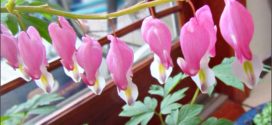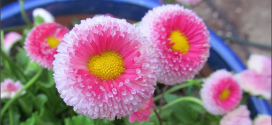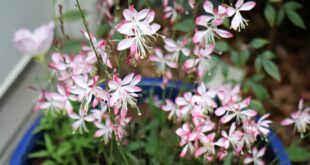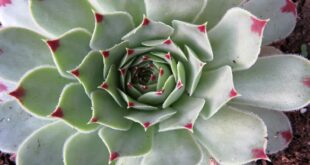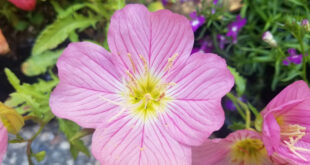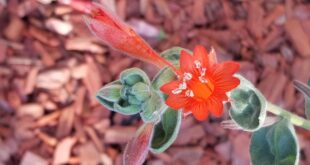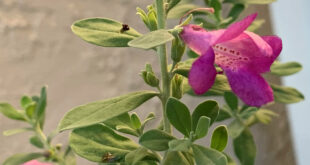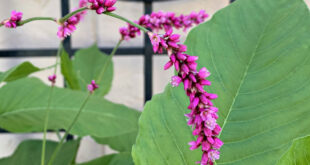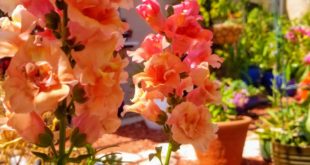The bleeding heart plant (Lamprocapnos spectabilis) has heart-shaped flowers that hang in rows on arching stems above soft, green foliage. This spring-blooming perennial has a short growing season. By midsummer, the whole plant dies back to the ground. Bleeding heart is hardy in U.S. Department of Agriculture (USDA) plant hardiness zones 3 through 9. Common Name: bleeding heart Type: Herbaceous …
Read More »Tag Archives: pink
English Daisy
English Daisies look like tiny daisies. Technically a perennial, English daisy is usually best treated as a biennial (it takes two years to bloom and then dies in the fall) in the South and an annual in the North. Plants survive down to about 10 degrees F so they can be planted in the fall in the South for early-spring …
Read More »Salvia greggii
Salvia greggii, the autumn sage, is a herbaceous perennial plant native to a long, narrow area from southwest Texas, through the Chihuahuan Desert and into the Mexican state of San Luis Potosi, typically growing in rocky soils at elevations from 5,000 to 9,000 ft (1,500 to 2,700 m). It was named and described in 1870 by botanist Asa Gray after …
Read More »Gaura – Pink Butterfly Bush
Gaura is a pretty summer-blooming plant for your Sunnyvale garden. As the flowers bob in the wind, they remind you of butterflies. Gaura is commonly grown as an ornamental plant. It is used in either garden beds or pots for accent colour and a delicate texture. It grows best in full sun and can survive lengthy periods of drought.There are many …
Read More »Hen-and-Chicks
New to our Sunnyvale garden in 2020 are Hen-and-chicks (Sempervivum tectorum ‘greenii’). This succulent forms a mat of rosettes, each 4″ across and only 2″ tall, in a lovely shade of blue-gray with each leaf tipped in deep red. Our plant was purchased from Annie’s Annual in Richmond. Older rosettes produce short stems of pink, narrow-petalled blossoms and then die, …
Read More »Pinkladies
Another new flower for our Sunnyvale Garden in 2020 are Pinkladies. Pinkladies (Oenothera speciosa) has masses of fragrant, bowl-shaped, satiny flowers. Other common names are evening primrose. We purchased our pinkladies from Summerwinds nursery. The large (2-3 inch wide) flowers open in the evening and remain open until late morning. The flowers age to rose-pink with deeper pink veins. They …
Read More »California Fuchsia
California Fuchsia (Zauschneria x cana ‘Calistoga Hybrids’) is a ground covering California native with large number of flowers that smother showy grey-green leaves on this low-water, low-maintenance, deer resistant, drought tolerant plant. Grown for its broad, grey leaves, low form and boldly colored carmine flowers, California Fuchsia prefer loose drainage, but adapt easily to clay soil. Plants do tend to …
Read More »Texas Sage
Our Sunnyvale garden has many drought-tolerant plants such as succulents, lavenders, and salvias. Texas Sage ‘Green Cloud’ is a recent purchase from Yamagami Nursery in West San Jose. Texas Sage (Leucophyllum fruitescens) has many common names, including Texas ranger, Texas rain sage, barometer bush, cenizo, silverleaf, and ash-leaf. The plant is not a sage (Salvia ssp.) but it is native …
Read More »Kiss Me Over The Garden Gate
With its long chains of pink blossoms, kiss-me-over-the-garden-gate is a great addition to a garden. This plant will bloom from mid-summer until fall. It is a favorite cut flower and can be dried and used in floral arrangements. The large, coarse-textured foliage can create a backdrop for other plants. This fast-growing plant can grow to 7 feet tall and can …
Read More »Snapdragon
Antirrhinum majus ‘Chantilly Bronze’ Lots of flowers with an shifting color palette ( goldens, pinks and oranges to deep red) create STRONG and tall enduring vertical interest in a garden bed or a flower arrangement. The strapping 3′ stems maintain their upright stance, even under a bounty of delicately-scented, long-lasting blooms, from Spring all the way through Autumn. After the …
Read More »